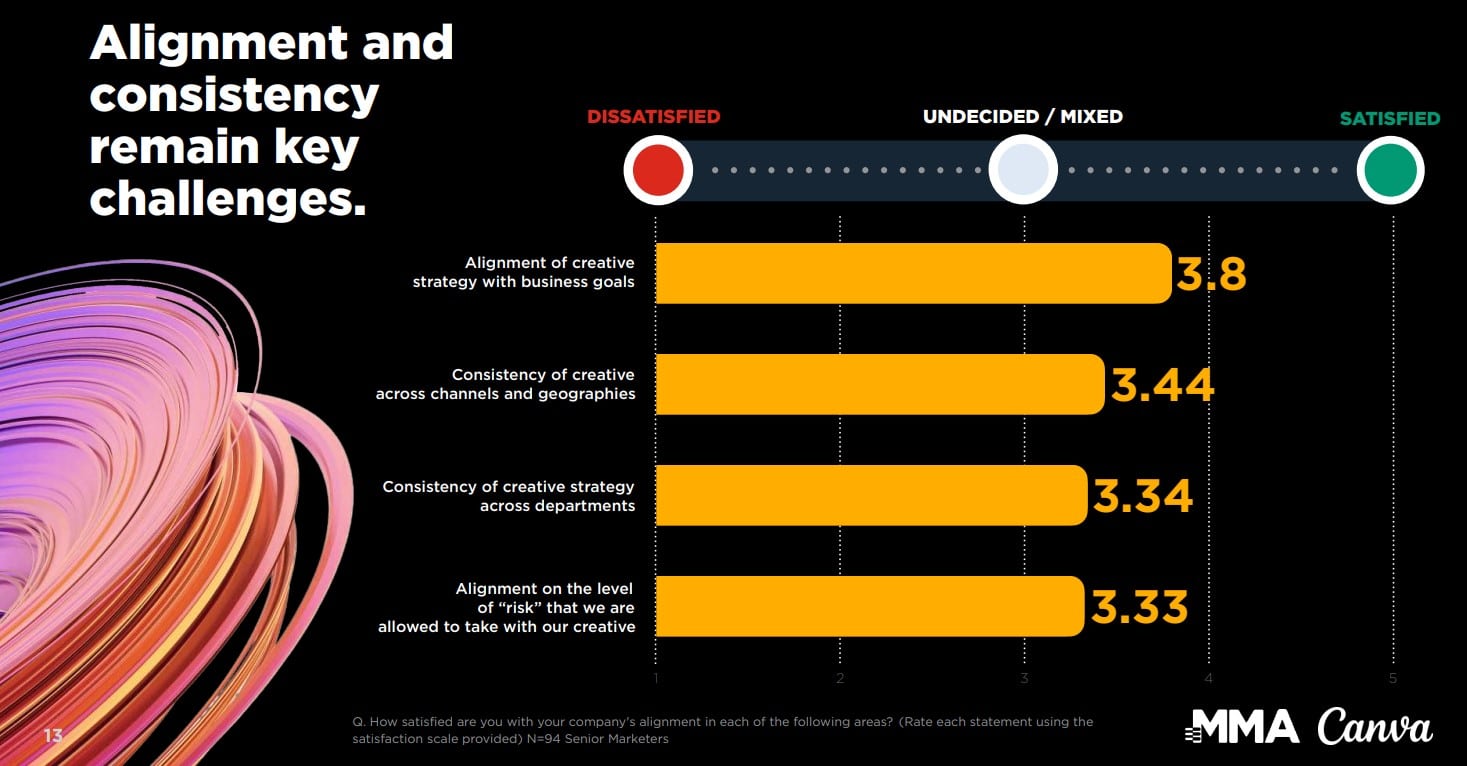With all the post-pandemic focus on personalized targeting, embracing the customer journey, collecting data and then panning for useful insights, and more recently, incorporating AI, marketers and communicators may have pushed their focus on creative output into the backseat. But industry execs are now realizing that creative—traditionally their ace in the hole—needs a comeback, according to new research from visual communication platform Canva and MMA Global, a global trade association for marketers, released joint research on the value of creative output, tech stack saturation and navigating talent wars.
For the new report, The State of Creative Process in Marketing, the firms surveyed nearly 100 CMOs and senior marketers in decision-making roles from the U.S. and the U.K, and found that in today’s hyper-competitive brand world, more than three-quarters (77 percent) believe creative output—encompassing all elements of campaigns and content—is more crucial now than ever before, with 69 percent saying that creative is a top marketing priority in their organization.

“While the last few years might seem solely focused on perfecting data, audience development, and targeting to drive outcomes, marketers are also recognizing the need to focus on a second creative revolution,” said MMA Global CEO Greg Stuart, in a news release. “Marketers face a pivotal moment where embracing AI and the challenge of managing the brand via what can be thousands of executions will redefine creativity’s role and brand communication, demanding a new and updated focus to managing the creative process.”
The survey revealed a variety of external forces fueling creativity in new ways, and a number of obstacles blocking marketers from unlocking full creative potential. Top findings include:
Creative output is the new gold standard
Marketing leaders are placing increasing value on creative, and there’s expectation this trend will continue.
- More than two-thirds (68 percent) believe that creative will become more important to their organization in the next 12 months.
- 72 percent believe that creative output adds value to customers’ lives.
But creative investment is falling short of proven worth
Despite the increasing value placed on creative, there is a significant gap in investment.
- More than half (55 percent) invest 10 to 25 percent of their total marketing budget on creative, while nearly a fifth (18 percent) invest less than 10% on creative.
- 41 percent say they aren’t making the right level of investment in creative tools, systems and technologies.

The creative process has increased in complexity
Today’s ecosystem of creative tools is bringing plenty of improvements, but not without new challenges.
- The following elements are ranked as more challenging now (46 percent) than they were five years ago: managing resources and budgets, maintaining consistency of output, and managing systems and tools.
- Most positive benefits come from the following tools, either by increasing efficiency or improving the creative output: collaboration platforms (54%), photo/video editing tools (54 percent), generative AI tools (35 percent).
Keeping pace with technological advances is a struggle
Marketing leaders are mostly confident in their creative output when compared to competitors, but there are areas where they feel outpaced.
- Comparing their creative output and processes to competitors:
- 34 percent believe their creative output is better, and 53 percent believe it’s on par.
- 45 percent believe they’re worse at managing a creative process that optimizes for speed, efficiency and flexibility.
In-house model gains in appeal
The landscape of creative management is shifting with more work being brought in-house vs. outsourced to agencies. In-sourcing is mostly seen as a superior process for teams, but outsourcing is used when there is a need to collaborate on high impact creative output.
- 30 percent have moved more work in-house in the last 12 months, and 31% expect to do the same in the next year.
- 48 percent say creative strategy is mostly done in-house, while 23% say it’s mostly outsourced.
- 83 percent say that in-house is better from a cost perspective, while 61 percent say that outsourcing is better for the quality of creative output.
The pool for top creative talent is shrinking
There’s concern about a diminishing pool of strong creative talent, underscoring the challenge of securing, managing and retaining talent in a competitive market.
- 47 percent say the pool of strong talent has gotten smaller.
- 80 percent feel satisfied with outsourced creative talent and resources; while 74% feel satisfied with in-house creative talent or resources.

“Producing stellar creative output while optimizing for resource efficiency is a massive challenge for every modern marketer today. How brands show up has gotten more competitive, there is a lot of tech to wade through, and the talent pool is narrowing,” said Canva CMO Zach Kitschke, in the release. “We’re delighted to work with the MMA team to identify the pain points and opportunities that marketers are facing today, in order to shed light on top-of-mind issues to inform their decision making.”
Download the full report here.
The study used an online questionnaire. Fieldwork was conducted in May 2024, among large marketers (72 percent have revenues over $1BN), across a variety of sectors. Respondents were senior marketers (C-Level 32 percent, EVP/SVP/VP 35 percent, Other senior 32 percent).







